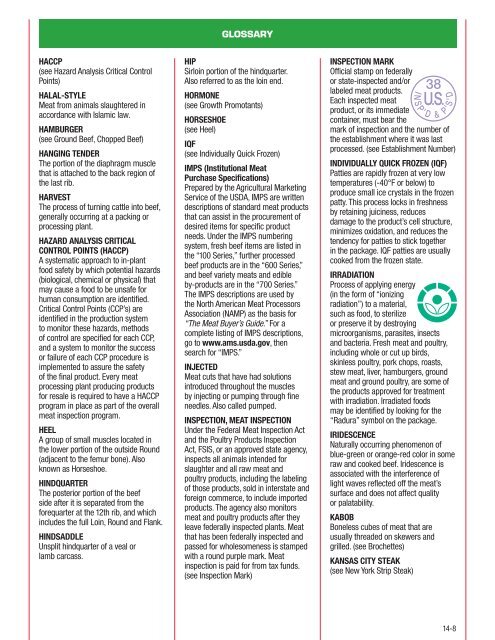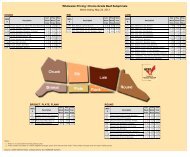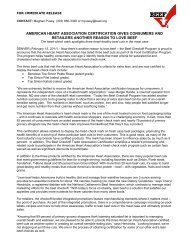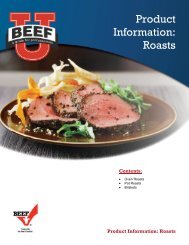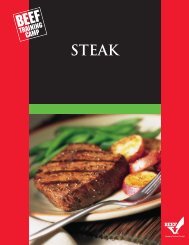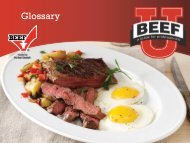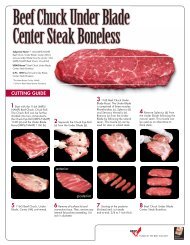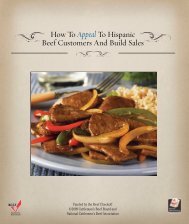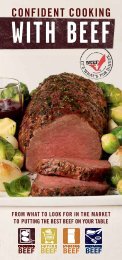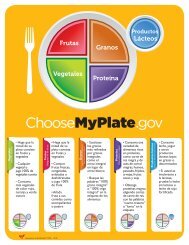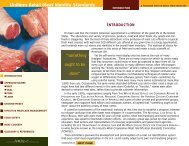NCBA BTC 2 S14 - BeefRetail.org
NCBA BTC 2 S14 - BeefRetail.org
NCBA BTC 2 S14 - BeefRetail.org
Create successful ePaper yourself
Turn your PDF publications into a flip-book with our unique Google optimized e-Paper software.
GLOSSARY<br />
HACCP<br />
(see Hazard Analysis Critical Control<br />
Points)<br />
HALAL-STYLE<br />
Meat from animals slaughtered in<br />
accordance with Islamic law.<br />
HAMBURGER<br />
(see Ground Beef, Chopped Beef)<br />
HANGING TENDER<br />
The portion of the diaphragm muscle<br />
that is attached to the back region of<br />
the last rib.<br />
HARVEST<br />
The process of turning cattle into beef,<br />
generally occurring at a packing or<br />
processing plant.<br />
HAZARD ANALYSIS CRITICAL<br />
CONTROL POINTS (HACCP)<br />
A systematic approach to in-plant<br />
food safety by which potential hazards<br />
(biological, chemical or physical) that<br />
may cause a food to be unsafe for<br />
human consumption are identified.<br />
Critical Control Points (CCP’s) are<br />
identified in the production system<br />
to monitor these hazards, methods<br />
of control are specified for each CCP,<br />
and a system to monitor the success<br />
or failure of each CCP procedure is<br />
implemented to assure the safety<br />
of the final product. Every meat<br />
processing plant producing products<br />
for resale is required to have a HACCP<br />
program in place as part of the overall<br />
meat inspection program.<br />
HEEL<br />
A group of small muscles located in<br />
the lower portion of the outside Round<br />
(adjacent to the femur bone). Also<br />
known as Horseshoe.<br />
HINDQUARTER<br />
The posterior portion of the beef<br />
side after it is separated from the<br />
forequarter at the 12th rib, and which<br />
includes the full Loin, Round and Flank.<br />
HINDSADDLE<br />
Unsplit hindquarter of a veal or<br />
lamb carcass.<br />
HIP<br />
Sirloin portion of the hindquarter.<br />
Also referred to as the loin end.<br />
HORMONE<br />
(see Growth Promotants)<br />
HORSESHOE<br />
(see Heel)<br />
IQF<br />
(see Individually Quick Frozen)<br />
IMPS (Institutional Meat<br />
Purchase Specifications)<br />
Prepared by the Agricultural Marketing<br />
Service of the USDA, IMPS are written<br />
descriptions of standard meat products<br />
that can assist in the procurement of<br />
desired items for specific product<br />
needs. Under the IMPS numbering<br />
system, fresh beef items are listed in<br />
the “100 Series,” further processed<br />
beef products are in the “600 Series,”<br />
and beef variety meats and edible<br />
by-products are in the “700 Series.”<br />
The IMPS descriptions are used by<br />
the North American Meat Processors<br />
Association (NAMP) as the basis for<br />
“The Meat Buyer’s Guide.” For a<br />
complete listing of IMPS descriptions,<br />
go to www.ams.usda.gov, then<br />
search for “IMPS.”<br />
INJECTED<br />
Meat cuts that have had solutions<br />
introduced throughout the muscles<br />
by injecting or pumping through fine<br />
needles. Also called pumped.<br />
INSPECTION, MEAT INSPECTION<br />
Under the Federal Meat Inspection Act<br />
and the Poultry Products Inspection<br />
Act, FSIS, or an approved state agency,<br />
inspects all animals intended for<br />
slaughter and all raw meat and<br />
poultry products, including the labeling<br />
of those products, sold in interstate and<br />
foreign commerce, to include imported<br />
products. The agency also monitors<br />
meat and poultry products after they<br />
leave federally inspected plants. Meat<br />
that has been federally inspected and<br />
passed for wholesomeness is stamped<br />
with a round purple mark. Meat<br />
inspection is paid for from tax funds.<br />
(see Inspection Mark)<br />
INSPECTION MARK<br />
Official stamp on federally<br />
or state-inspected and/or<br />
labeled meat products.<br />
Each inspected meat<br />
product, or its immediate<br />
container, must bear the<br />
I N S P<br />
38<br />
U.S.<br />
' D<br />
P<br />
mark of inspection and the number of<br />
the establishment where it was last<br />
processed. (see Establishment Number)<br />
INDIVIDUALLY QUICK FROZEN (IQF)<br />
Patties are rapidly frozen at very low<br />
temperatures (-40°F or below) to<br />
produce small ice crystals in the frozen<br />
patty. This process locks in freshness<br />
by retaining juiciness, reduces<br />
damage to the product’s cell structure,<br />
minimizes oxidation, and reduces the<br />
tendency for patties to stick together<br />
in the package. IQF patties are usually<br />
cooked from the frozen state.<br />
IRRADIATION<br />
Process of applying energy<br />
(in the form of “ionizing<br />
radiation”) to a material,<br />
such as food, to sterilize<br />
or preserve it by destroying<br />
micro<strong>org</strong>anisms, parasites, insects<br />
and bacteria. Fresh meat and poultry,<br />
including whole or cut up birds,<br />
skinless poultry, pork chops, roasts,<br />
stew meat, liver, hamburgers, ground<br />
meat and ground poultry, are some of<br />
the products approved for treatment<br />
with irradiation. Irradiated foods<br />
may be identified by looking for the<br />
“Radura” symbol on the package.<br />
IRIDESCENCE<br />
Naturally occurring phenomenon of<br />
blue-green or orange-red color in some<br />
raw and cooked beef. Iridescence is<br />
associated with the interference of<br />
light waves reflected off the meat’s<br />
surface and does not affect quality<br />
or palatability.<br />
KABOB<br />
Boneless cubes of meat that are<br />
usually threaded on skewers and<br />
grilled. (see Brochettes)<br />
KANSAS CITY STEAK<br />
(see New York Strip Steak)<br />
&<br />
' D<br />
' S<br />
14-8


